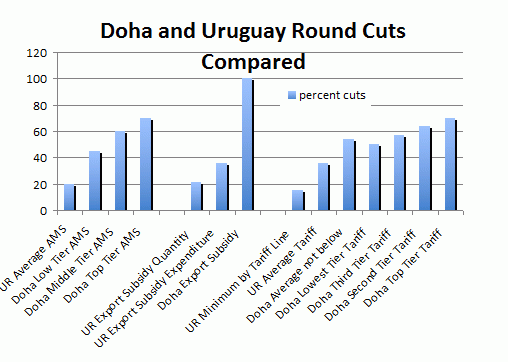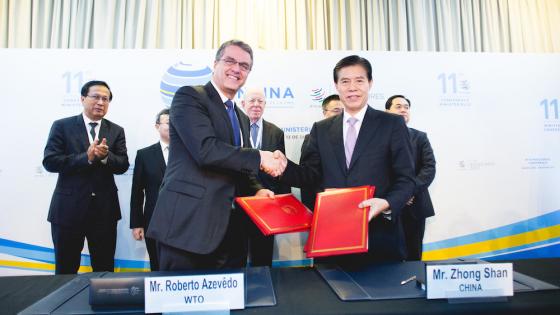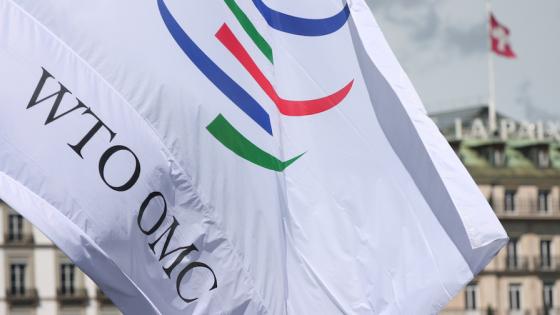Prospects for a conclusion of the Doha Round in 2011 seem to be receding. Countries still seem far apart in their own perceptions of an acceptable outcome. As usual, agriculture has been among the most difficult topics on which to reach agreement. But on this occasion it is not agriculture that is holding up the final deal. Indeed, the agricultural modalities text has been largely in place since December 2008, subject to a small number of issues that have been waiting until the conclusion of other area of the negotiations (WTO 2008). So it is possible to see what is at stake for agricultural trade and for the resolution of the problems that still bedevil this vital part of the trade system.
The agenda of the Doha agricultural talks is rooted in the Uruguay Round Agreement on Agriculture. It was clear at that moment that reform would take time. Decades of accumulated impediments to an open food and agricultural trade system would not be dissolved in a single Round. It was a Herculean task to set the rules for agricultural trade and constrain border and domestic policy measures. But the next step was to scale back tariffs to a level where conventional negotiations could eventually eliminate the major distortions in the global food and agricultural market. Along with this would come the elimination of export subsidies and the most trade-distorting domestic subsidies that were a part of industrial country’s farm policies. What is on the table in the Doha Round essentially does just that.
The significance of the Doha Round constraints relative to those of the Uruguay Round is shown in Figure 1. In each of the three “pillars” of the Uruguay Round Agreement on Agriculture the Doha Round draft modalities of December 2008 makes much deeper cuts (though from a slightly lower base). In domestic support, the cuts would essentially end the price-support systems in major developed countries (US, EU and Japan) and force major changes in others (Norway and Switzerland). It is not too strong to say that industrial-countries policies that intervene in agricultural markets would no longer be a significant cause of trade distortions. Export subsidies and export credit, state trading and surplus disposal of grains as food aid would also be ended. Tariffs will be reduced significantly though some sensitive products would continue to have high tariffs. Developed countries would have to reduce overall agricultural tariffs by at least 54%. It is difficult to think of a more sweeping set of tariff reductions in agricultural or other goods.
Figure 1. Doha and Uruguay Round cuts compared
Source: Hebebrand and Josling (2011).
So why is this not being hailed as a major accomplishment and why does it not provide a major incentive for the Round to be completed? Developing countries seem to be aware of its significance and are out ahead in arguing for a conclusion to the Round. European farmers may not be enthusiastic, but they seem to be reconciled to see some multilateral market opening. Japanese farmers are also keeping a low profile, banking on generous compensation from their government. But it is the US that seems to be withholding support for an agreement, arguing that constraints on US domestic programmes must be matched by improved access into emerging country markets. It is ironic that the long-standing objectives of farm organisations to pin down the EU’s CAP and to reduce peak tariffs in other countries should be so close to realisation and yet generate no enthusiasm.
There is still time for the benefits of the further constraints on domestic farm policies to be realised. But even if the Round were to be rescued it would not resolve all the issues in the area of domestic support. Indeed it would expose several underlying problems that will need to be tackled. At the end of the transition period, the balance of “allowable” expenditure on trade-distorting support would shift towards developing countries. Brink (2011) has calculated that the post-Doha limits on such support would be $86 billion for India and $26 billion for China. By contrast the limits for the EU would be $33 billion and for the US $15 billion. There is not much evidence that developing countries will have the financial resources to spend up to their limits, but it does raise questions about the balance of support to agriculture in the future. Allied to that issue are questions about the trade-distorting nature of direct payments, now the dominant instrument in the EU and the US. Switching to direct support has clearly removed some distortions, but these policies are not quite trade-neutral. Some distinction between such income payments and other green box policies that provide public goods may be an urgent item on any future agenda. And payments to expand markets for agricultural goods (domestic food aid) along with those to restrict production (conservation payments) may well come under increased scrutiny for their impacts on food prices. One such programme, i.e. the subsidies given to promote biofuel use, has already been widely criticised.
If indeed the Round is abandoned or put on an indefinite hold, can anything be rescued from the current Round? Perhaps the most likely part of the Doha modalities that could be rescued is the improvement in the rules concerning export competition. The key to such an agreement rests on the fact that only a few countries use export subsidies and equivalent measures. The ability to continue such export subsidies when included the Uruguay Round commitments was intended to be a temporary exclusion from the disciplines of the Subsidies and Countervailing Measures Agreement that bans export subsidies for all other goods. Agreeing to phase out these subsides would require a “self-denying ordinance” on the part of the US, the EU, Argentina, Canada and Australia. This would be a good example of a “critical mass” agreement, as countries that do not use export subsidies would have to undertake any new obligations.
Could countries also rescue an agreement on domestic support in the absence of a broader Doha deal? The US, the EU and Japan have adequate “space” to agree to the major cuts envisaged in the Doha draft modalities (Orden et al. 2011). Budget constraints are much more significant than trade rules on farm policies in most developed countries. But whether this makes it easier to get an agreement among developed countries (perhaps in the OECD) to impose limits on trade-distorting support is not clear. Without any credible threat that EU policy will turn back to protection it may be too much to ask the US Congress to limit its own policy flexibility.
Market access talks have always been the centrepiece of multilateral trade negotiations, but most tariff reductions in recent years have taken place either unilaterally or as a result of preferential agreements. So the relevant question is whether tariff cutting in agricultural markets is easier to negotiate on a bilateral or regional basis. No matter what one thinks of the broader systemic inconsistencies between multilateral and preferential tariff cuts, it appears that it is easier to open markets in piecemeal fashion. The advantage of regional agreements is that the default is zero bilateral tariffs. Exceptions have to be “bought” at the negotiating table. This makes it more “expensive” for particular sectors to slow down the process of market opening.
Conclusions
So some aspects of the Doha agenda may be saved by plurilateral deals and others may be taken over by preferential deals. But perhaps the most disturbing aspect of a breakdown in the Doha Round may not in fact be in the current agenda. Many other issues need to be addressed that have more impact on agricultural and food trade than domestic and export subsidies. These include the response to price volatility, where the use of export taxes has exacerbated the problems and put additional strains on the trade system, and the emergence of a range of private food standards, which are seen by many developing countries as a threat to market access. Such topics will become more important over time. The Doha Round is still addressing agricultural trade issues of the 1980s, and is delaying the consideration of more pressing matters.
References
Brink, Lars (2011). “The WTO Disciplines on Domestic Support”, in David Orden, David Blandford and Tim Josling (eds.), WTO Disciplines on Agricultural Support: Seeking a Fair Basis for Trade. Cambridge University Press
Hebebrand, Charlotte and Tim Josling, (2011), “Doha and Beyond: Continuing the reform of the International Trade System for Food and Agricultural Products”, Background paper for International Food and Agricultural Trade Policy Council, Washington, DC.
Orden, David, David Blandford and Tim Josling (2011), “The Difficult Task of Disciplining Domestic Support”, in David Orden, David Blandford and Tim Josling (eds.) WTO Disciplines on Agricultural Support: Seeking a Fair Basis for Trade, Cambridge University Press
World Trade Organization (WTO) (2008), “Revised draft modalities for agriculture”, TN/AG/W/4/Rev.4,



